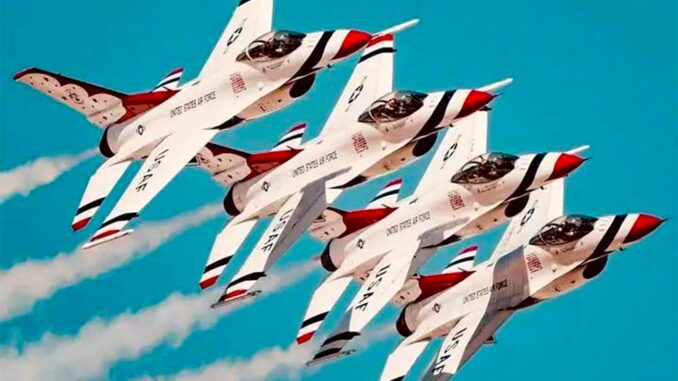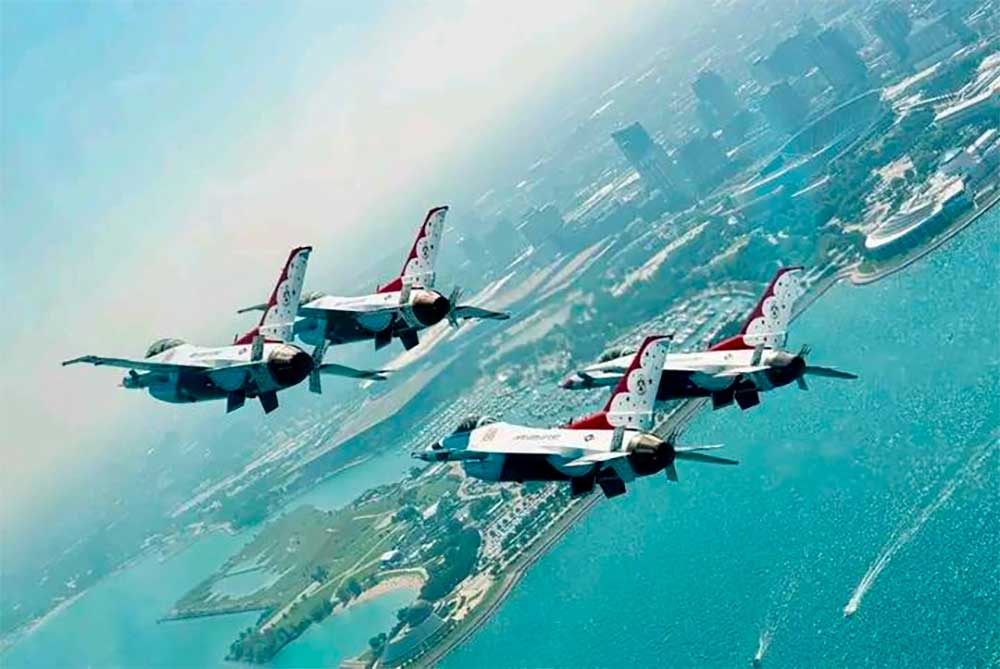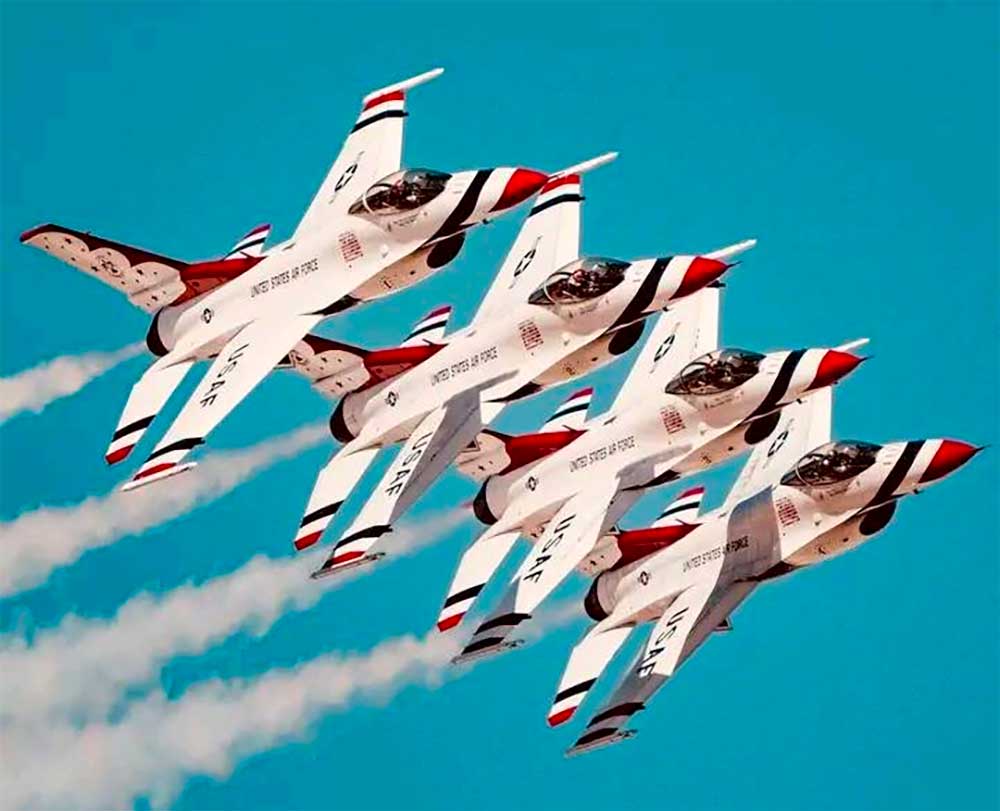
Explore the training, selection, skills, missions, duration, salary, and lifestyle required to become a U.S. Air Force Thunderbirds pilot.
The Thunderbirds: America’s elite demonstration squadron
The U.S. Air Force Thunderbirds are the official aerial demonstration team of the United States Air Force, based at Nellis Air Force Base in Nevada. Created in 1953, the team represents the pinnacle of precision flying, showcasing American airpower and the professionalism of Air Force aviators.
Flying the F-16 Fighting Falcon, Thunderbirds pilots perform close formation aerobatics at speeds up to 1,000 km/h (≈ 600 mph), sometimes with as little as 90 cm (3 feet) of separation between aircraft. To become a Thunderbirds pilot is to reach one of the highest levels of recognition in U.S. military aviation.

The training of a U.S. fighter pilot
The path to becoming a Thunderbirds pilot begins with the training of a U.S. fighter pilot. After earning a commission through the U.S. Air Force Academy, ROTC, or Officer Training School, candidates attend Undergraduate Pilot Training (UPT).
UPT lasts about 12 months, during which students accumulate around 200 flight hours in the T-6 Texan II and T-38 Talon. The best graduates are assigned to fighter aircraft. From there, pilots undergo Introduction to Fighter Fundamentals (IFF) before progressing to the F-16 B-Course, where they learn air-to-air and air-to-ground combat.
By the time a candidate becomes eligible for the Thunderbirds, he or she will typically have accumulated 1,000 to 1,500 flight hours in fighter jets and several operational deployments.
The selection process: criteria of excellence
The recruitment of a Thunderbirds pilot is a highly selective process. Applicants must be experienced fighter pilots, with at least 750 hours of fighter flight time.
Each year, only a handful of slots open within the squadron. Candidates are evaluated not only on their technical skills, but also on their leadership, teamwork, and ability to represent the U.S. Air Force in public.
The selection process includes a review of flight records, recommendations from commanders, interviews with current Thunderbirds members, and in some cases observed flights. The criteria for selection ensure that only pilots with exceptional skill and maturity join the team.
The qualities required to join the Thunderbirds
The qualities required to become a Thunderbirds pilot go beyond flying skills. Pilots must withstand G-forces ranging from −3G to +9G, maintain mental clarity under extreme physical stress, and demonstrate absolute precision in close formation flying.
Equally important are interpersonal skills. Thunderbirds pilots interact constantly with the public, schools, media, and international partners. Humility, communication ability, and a sense of service are essential. Each pilot is an ambassador of the U.S. Air Force as much as a demonstration aviator.
The duration of assignment and daily routine
A pilot’s assignment to the Thunderbirds typically lasts two years, though some remain for a third year. This limited duration ensures a constant flow of fresh experience from operational units.
The daily training routine is intense. During the winter season at Nellis AFB, pilots train up to five days per week, flying two sorties per day. Each flight is preceded by a detailed briefing and followed by a comprehensive debrief, where maneuvers are analyzed second by second.
During the airshow season, the team performs around 75 demonstrations per year across the United States and internationally. The pace requires both physical endurance and constant mental focus.
The missions and role of the Thunderbirds
The mission of the Thunderbirds is threefold:
- To demonstrate the professionalism of U.S. Air Force pilots.
- To inspire future generations to pursue aviation and military service.
- To strengthen ties with the public and U.S. allies abroad.
The Thunderbirds are therefore not only an aerobatic team but also a strategic communication tool. They represent American airpower at home and internationally, making their pilots both combat aviators and public ambassadors.
The salary and advantages of a Thunderbirds pilot
A Thunderbirds pilot receives the same pay as any U.S. Air Force officer of similar rank and experience. A captain (O-3) with around 10 years of service typically earns \$90,000 to \$110,000 per year, including base pay, flight pay, and allowances. A major (O-4) earns proportionally more.
Additional advantages include healthcare, retirement contributions, housing allowances, and 30 days of paid leave per year. The intangible benefits are significant: prestige, visibility, and the honor of serving as one of the most recognized faces of the U.S. Air Force.

The career path after the Thunderbirds
After their assignment with the Thunderbirds, pilots return to operational units, often in leadership positions. Some go on to command fighter squadrons or serve in staff roles at higher headquarters.
The progression of a career toward the Thunderbirds strengthens a pilot’s profile, often accelerating future opportunities within the Air Force. The experience of precision flying, combined with public engagement, prepares them for responsibilities that combine tactical excellence and strategic communication.
The reality behind the dream
Becoming a Thunderbirds pilot is not only about aerobatic displays. It is the culmination of years of demanding training, operational deployments, and relentless dedication. Only a select few reach this level, but for those who do, the assignment is both a professional honor and a personal challenge.
The Thunderbirds illustrate what it means to blend discipline, skill, and representation. Each flight is a demonstration of precision, teamwork, and trust. The assignment is short, but its impact lasts a lifetime, marking the pinnacle of a fighter pilot’s career.
War Wings Daily is an independant magazine.